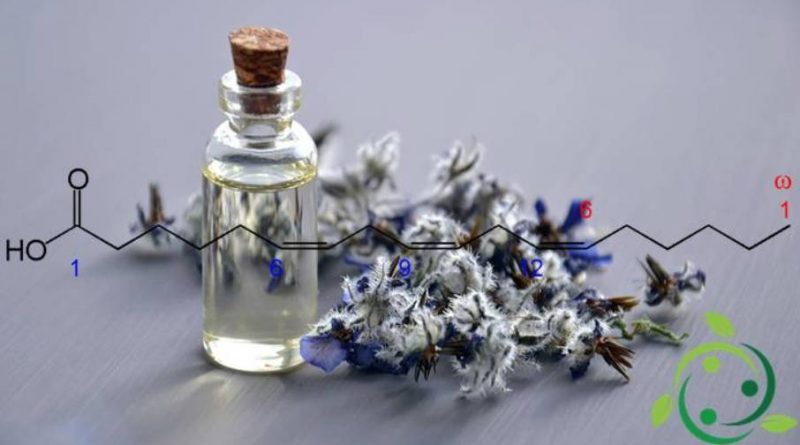γ-linolenic acid
Γ-linolenic acid
γ-linolenic acid, also known as GLA and whose name in the official IUPAC nomenclature is: acid (6Z, 9Z, 12Z) -octaec-6,9,12-trienoic acid and whose brute or molecular formula is: C18H30O2 is a n-6 fatty acid (also called ω-6 or 18:03), which means that the first double bond starting from the last methyl group (designated with no ω) is on the sixth link.
γ-linolenic acid is a carboxylic acid with 18-carbon chain and three cis double bonds.
γ-linolenic acid is an isomer of α-linolenic acid, which is an omega-3 polyunsaturated fatty acid.
In nature, γ-linolenic acid is a fatty acid found mainly in vegetable oils.
The main sources include:
– Borage (Borago officinalis L.) of the Boraginaceae family, the most concentrated form, from 20% to 27% of the total fatty acids. It is common in the Mediterranean region in North Africa;
– Common Evening Primrose (Oenothera biennis L.), belonging to the Onagraceae family, good source, from 7% to 14%. It grows in North America;
– Black currant (Ribes nigrum) belonging to the Saxifragaceae family, another good source, from 15% to 19%. It grows mainly in Europe;
it is also present in other plant species such as Cannabis sativa, belonging to the Cannabaceae, Minuartia laricifolia, belonging to the Caryophyllaceae, and several microorganisms and fungi.
In the diet the linolenic acid is introduced sufficiently thanks to abundant sources such as cooking oils and meats. However, the lack of GLA can occur when there is a reduction in the efficiency of the D6D conversion (for example, with advancing age or when there are specific dietary deficiencies) or in disease states where there is increased consumption of the metabolites of γ-linolenic acid.
At the metabolic level the human body produces γ-linolenic acid starting from linoleic acid (LA) through the enzyme Δ6-desaturase (D6D), an enzyme that catalyzes the formation of a double bond on the sixth carbon starting from the carboxylic terminal.
γ-linolenic acid, by bypassing the reazione6-desaturase-catalyzed reaction, is rapidly extended to diomo-γ-linolenic acid, thus increasing its concentration.
Diomo-γ-linolenic acid is also:
– the precursor for the biosynthesis of PGE1 and 15-HETrE that in vivo attenuate the inflammatory and proliferative processes;
– competes with arachidonic acid for incorporation into membrane phospholipids, decreasing the amount of arachidonic acid and thus contributing to the maintenance of normal fluidity of the cell membrane.
Obviously the biological efficacy of ingested γ-linolenic acid depends on the daily quantity.
γ-linolenic acid is sold as a dietary supplement for the treatment of problems such as inflammation and autoimmune diseases, even if its effectiveness is controversial.
Warning: The information given is not medical advice and may not be accurate. The contents are for illustrative purposes only and do not replace medical advice.

